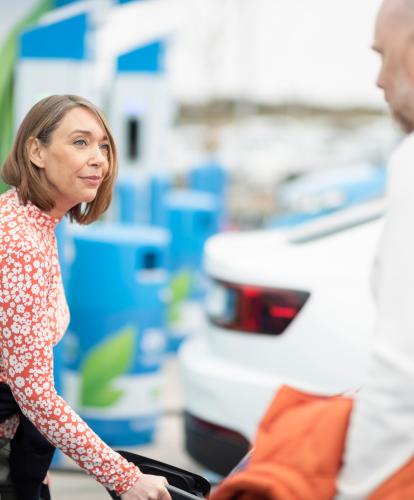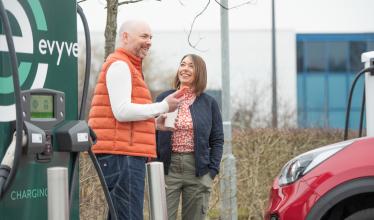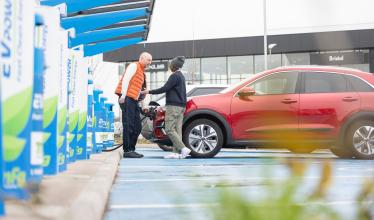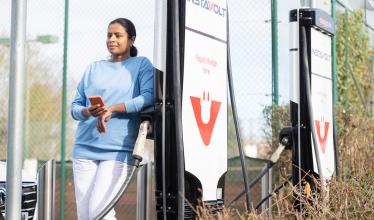In recent years, the automotive industry has witnessed a shift towards sustainability and innovation with the rise of electric vehicles (EVs). However, as we embark on this electrifying journey into the future of transportation, it’s important that we address an essential aspect of this revolution - ensuring that the EV experience is inclusive and tailored to the needs and preferences of women.
The 'car conversation' has historically been one from which women have been left out, often relegated to the sidelines of an industry primarily targeting men.
Manufacturers have rarely taken into account the unique perspectives and requirements of female consumers, with even the design and safety features of cars crafted with a predominantly male audience in mind.
But times are changing, and a new era of EVs is dawning, especially with the impending 2035 ban on the production of petrol and diesel motors in the UK.
In this piece, our aim is to shed light on some of the challenges that many women face when embracing electric mobility, as well as offer helpful tips to best navigate electric car ownership – and, of course, EV charging.
Making the switch
Sticking with what you know can be the safer option when it comes to any new purchase, especially larger purchases such as cars. Change can be scary and bring unexpected issues. There’s a reason why so many people are brand loyal: they like what they know and they know what they like.
But with approximately 1.5 million fully electric cars on UK roads and counting, it’s not only the tech pioneers and early adopters embracing electric. We’re well on the way to EVs becoming the new normal.
However, we know from our latest EV charging survey of over 4,000 electric car drivers that only 12% of its respondents were female. Meanwhile, a separate survey from Auto Trader (No Driver Left Behind), found that – of the people surveyed – only 7% of women currently owned an EV, compared to 16% of men.
Despite this, many who have made the switch to electric are generally very positive about the change.

"I've had my electric car for four years and would never even think about going back to petrol," says Eleanor Field, Senior Project Manager at Zapmap.
"I've learnt that electric cars are much simpler to maintain. There are fewer moving parts to go wrong, and they're also a pleasure to drive. They are quiet (no noisy engine), automatic and include plenty of useful gadgets like auto-locking when you walk away, and automatic headlight dimming.
"When I'm looking for charging locations, I use the Zapmap app with its handy filtering of location types. If I select ‘Supermarket,’ I can fit in a shop while I'm waiting for the car to charge. Very convenient!"
Better, clearer information around charging
Given the findings above, providing clearer information about electric cars and charging them is one way to help give female drivers greater confidence in making the switch to an EV. Indeed, for a driver who has only ever popped open a fuel cap and filled a car with petrol or diesel, EV charging can seem like a whole new world.
For example, you probably had a parent or an older sibling show you how a fuel pump works, but this may not be possible with an electric car.
So here’s a quick cheat sheet for you to understand some of the nuances of EV charging:
- What's a kilowatt? A kilowatt (kW) literally means one thousand watts.
- A kilowatt-hour (kWh) measures the energy delivered by one kilowatt of power for one hour.
- A kW reflects the rate/speed of electricity usage, while a kWh reflects the total amount of electricity used.
- Mostly, the price of EV charging is measured in kWh. For example, you’ll see: 79p/kWh.
- The speed at which your EV can charge will depend on its battery size/capacity and the speed of the charger that you’re using.
- The cost of your charge will depend on the percentage of charge you wish to increase by, and the cost per kWh set by the provider.
- Take a look at our Zapmap Price Index to see how the cost of EV charging compares to petrol or diesel.
Luckily, organisations like She’s Electric and Women Drive Electric exist to guide and enable sustainability - and to help women make the switch to electric by giving you the confidence and knowledge you need to make a positive impact.
You can also explore our model charging guides for a deeper dive into particular car models if there are a couple you already have your eye on.
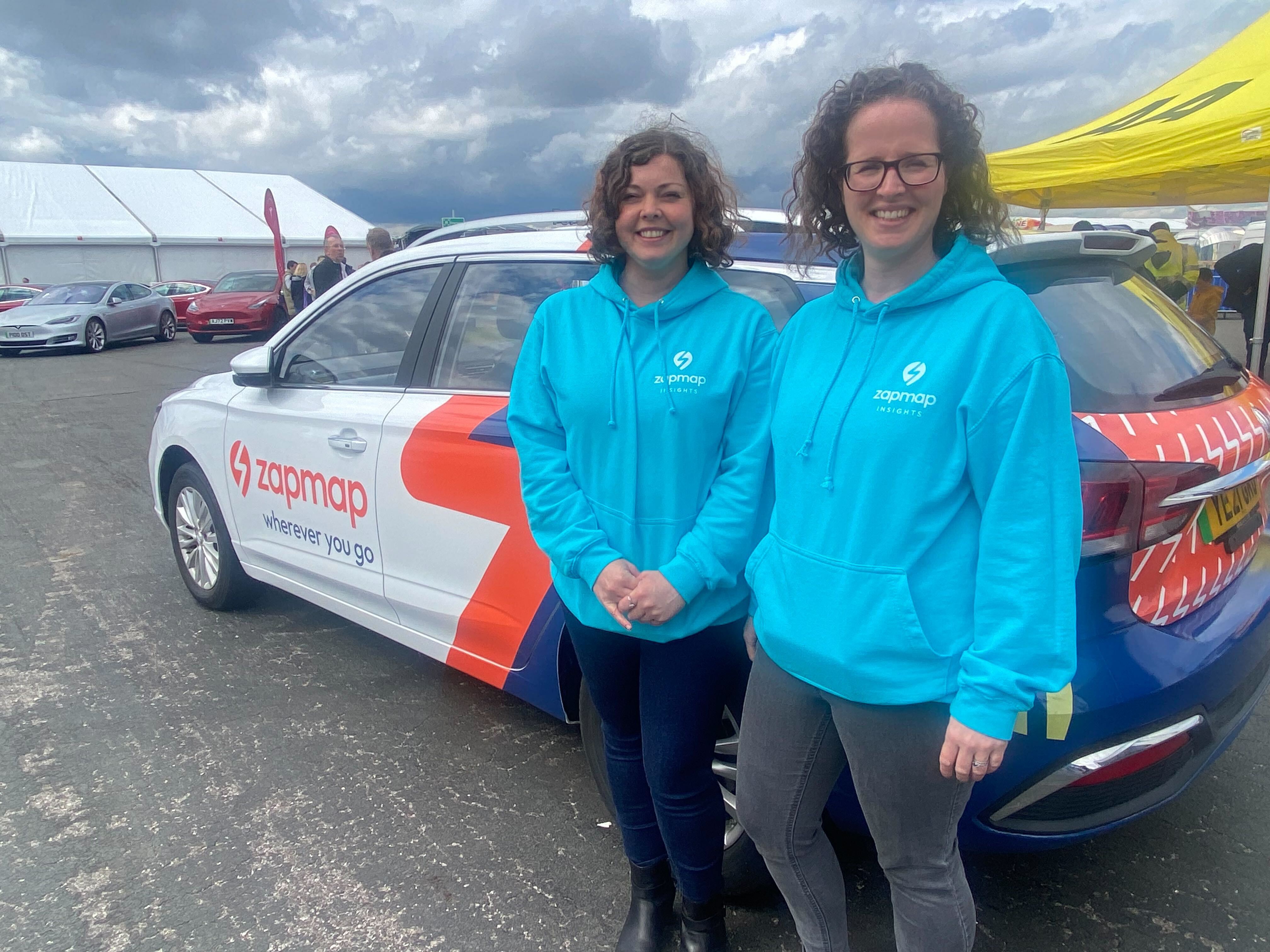
Harriet and Jade from the Zapmap Insights team attending Fully Charged Live South
Charging quickly and safely
Filling your car with petrol or diesel is mostly quick and easy, and drivers are used to stopping by a petrol station as and when required. When driving an EV, however, you can almost do away with the need to stop for fuel, especially if you have access to a home charger. So no more petrol on your hands from filling up!
Even so, the chances are you’ll likely need to stop and charge on the public charging network at some point, especially on longer journeys. And in these situations, we know from anecdotal evidence in Zapmap’s EV Cafe that women don’t tend to feel as safe as men about needing to wait around for their EV to charge, often in less than optimal surroundings.
This is supported by Auto Trader’s ‘No Driver Left Behind’ report, which revealed that 43% of women were worried about EV charging times, compared to just 35% of men. Overall, the findings showed that women were more likely to view charging as “risky.”
What’s more, Chargesafe – whose aim is to support a more inclusive charging experience by identifying where the public network needs to become safer and more accessible – has conducted research on this very topic. From a sample of 817 public charging locations in the UK, the company’s findings revealed that 87% had poor lighting and 77% didn’t have security cameras.
With this in mind, here are some of our key safety tips for charging on the public network, especially if you’re a woman:
- Choose the charge point that’s right for you. Use the Zapmap app to find a quick, available charge point. Our Live data partners all show their real-time availability status in the app 24/7. Plus, if you search for a charging hub with multiple charge points, you’re less likely to have to wait for an extended time.
- Access user reviews, photos and updates about chargers by looking in the Chat section of each charge point in the app. This could help you find a well-lit charge point with protection from the rain, for example. (Plus, remember to select ‘Check in’ to leave your own feedback, and add photos and info for other users in Zapmap's thriving community of EV drivers.)
- Plan to charge before your battery percentage gets very low. It’s good practice to leave a reserve for the health of the battery, and it’s common sense to not risk running dry if there are unexpected charging issues. You can plan your route on Zapmap, as well as select the level of charge you'd like remaining when you arriving at your charging pit stop.
Before leaving your car to plug in, take a look at your surroundings. If you don't feel safe, don't exit your car - and you can of course use Zapmap to locate another nearby charge point. If you opt to stay in your car while you charge, you may want to keep your doors locked.
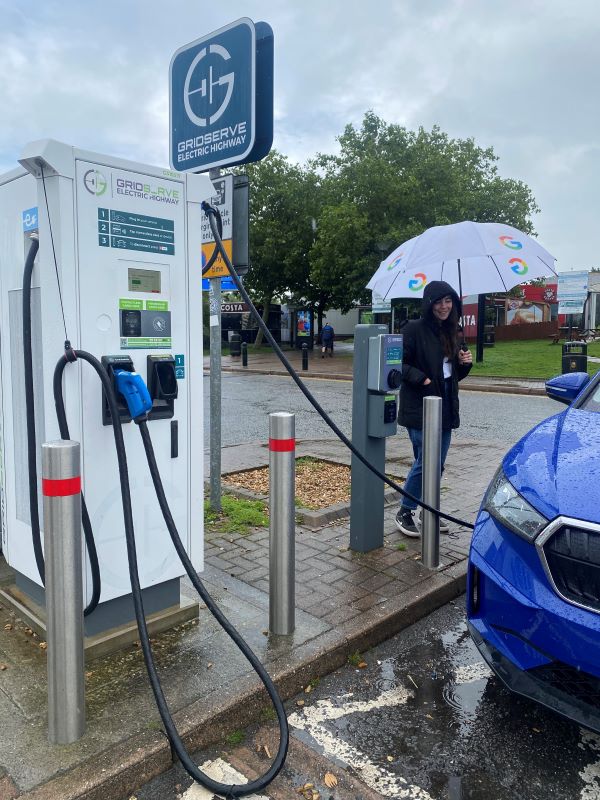
Zapmap’s Digital Content Producer Sofia stops for a quick charge in the rain
Charging an electric car without a driveway
If you happen to live in a flat, don't have off-street parking or maybe you rent your home and can’t install your own charger, that doesn’t have to stop you going electric.
Recently there’s been a big increase in the installation of on-street charging provision, designed specifically to cater to drivers without off-street parking. At the time of writing, there were 13,868 on-street charge points across the UK. Their distribution, however, is still relatively patchy because some local authorities are much further ahead in their rollout of on-street charging provision than others.
If you’re lucky enough to have some of these chargers on your street already, you’ll typically see them in the form of lamppost or bollard-style devices (3 - 7kW) that enable you to recharge your car overnight.
However, if you don’t yet have on-street provision on your doorstep, you should be able to find other ‘close-to-home’ options at a supermarket or local charging hub. Take a look on the Zapmap app, and you may be pleasantly surprised at what you see.
Finding the right range for your needs
Electric cars, like all new cars, can be expensive. While this can be off-putting, it’s worth highlighting that the longer-range EV models tend to have a higher price point due to their larger batteries and increased motor sizes.
So ask yourself, why do you need the car? How often, for example, do you actually take a 300-mile journey? How about 100 miles? In all likelihood, the answer to both is, ‘rarely.’ The average length of a car journey hovers somewhere around 10-15 miles, varying slightly each year.
If you’re willing to stop, charge and grab a coffee on the few occasions that you do take longer trips, a lower-range EV is likely far more affordable than you might expect, and probably better suits your needs. Plus, you may not even need to buy a new car outright anyway.
Check out second-hand, leasing or salary sacrifice
Purchasing a pre-owned EV is a brilliant way to access a world of sustainable transport in a more affordable way. Depending on your budget and requirements, you could find a second-hand EV for as low as £4,000, with reasonably low mileage and good condition for slightly older vehicles.
“When I bought my EV, it was already second-hand. Since then, I’ve loved driving it every minute and had very few issues,” says Eleanor. “It’s a joy to drive, to be honest.”
An even eco-friendlier alternative is via car-share options such as Co-Wheels, where you can access a range of EVs in your area for as little or as long as you’d like. Community car-sharing schemes are particularly suited to those who only require the use of a car once or twice a week or less.
Indeed, getting hold of an affordable electric car that meets your needs is becoming a lot easier than you might expect.
For example, the benefits of leasing a new car also apply to electric models, with many EV-dedicated providers offering particularly flexible solutions. You can even subscribe to an electric car now.
Other benefits include monthly payments, (often) the option to purchase at the end of your lease, being able to treat yourself to a newer model every few years for better range and potential reduced charging costs in models with better ‘fuel’ economy.
And last but certainly not least, salary sacrifice schemes are also a fantastic gateway into EV driving, and are often the most cost-effective way of accessing an electric car. It works by a portion of your pre-tax salary going towards the leasing of an EV. In most cases, the cost of servicing, insurance and tax is included in the cost. Plus, the wait times to receive the car are reduced, as many companies such as Tusker have EVs readily available in stock.
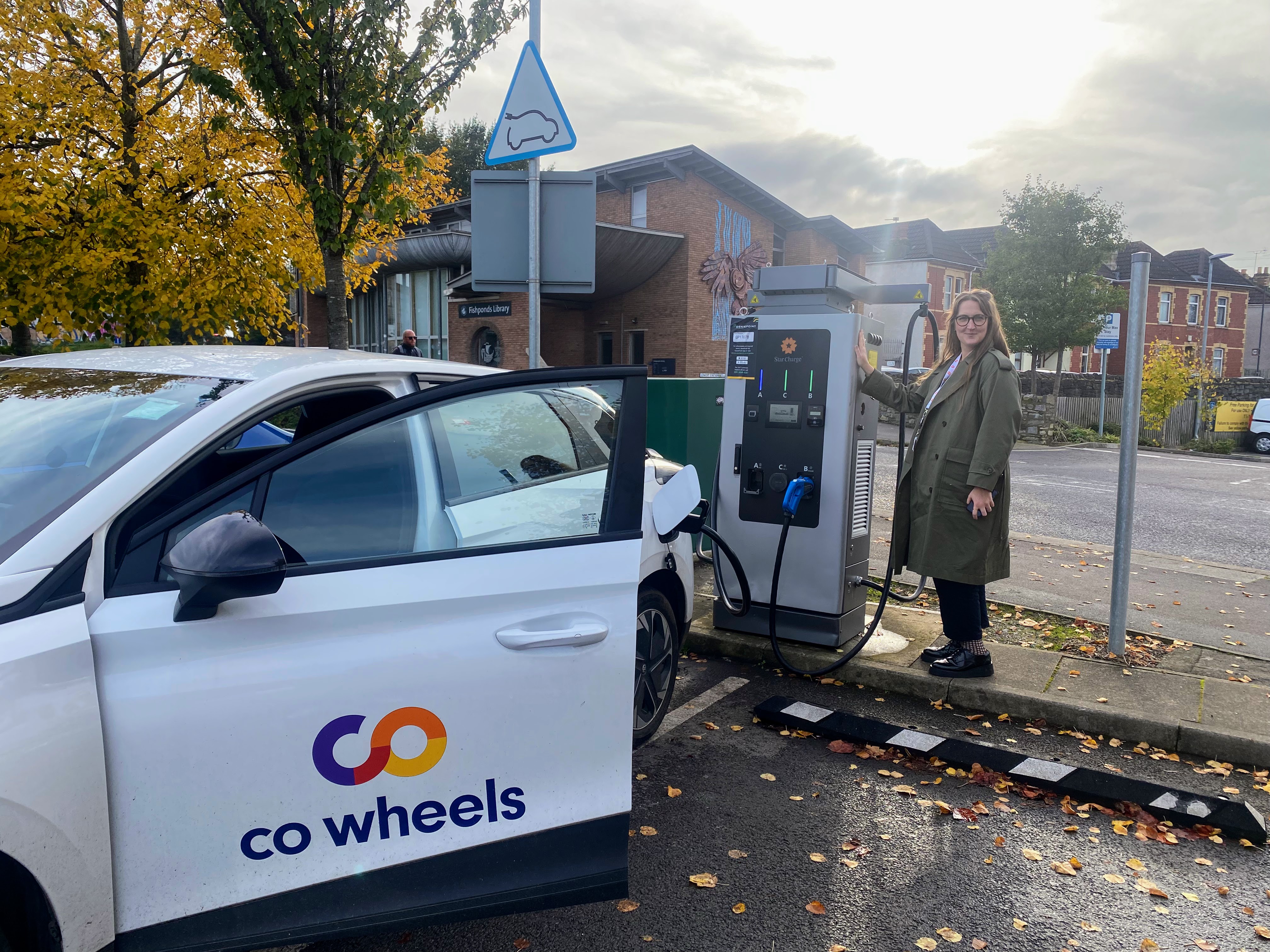
Zapmap Marketing Manager Lucy takes advantage of the Co-Wheels car club
The lifespan of EVs and their environmental impact
If you care about saving the planet and want to do more in your efforts for sustainability, purchasing an EV as your next car would make a big difference to your carbon output.
In 2021, a Reuters study discovered that the overall life-cycle emissions from EVs with a decarbonised power system could be 70-90% lower than those of petrol or diesel cars.
But what about the electricity required to power them? You’ll be pleased to know that most charge point operators have made it their mission to be net zero and only power their charge points using renewable energy.
And of course you have your own choice of provider when it comes to home charging. A number of providers now offer green tariffs, and even special tariffs for overnight EV charging.
While there were previously some concerns around the lifespan of EV batteries, many electric cars have now been running for more than ten years. This has provided various opportunities for research into EV battery degradation, which has proven to be fairly minimal as this Which? article addresses:
“As you might expect, newer EVs manage to maintain their range better than earlier models, with cars registered from 2019 onwards managing to deliver 98% of their original range on average," the article states.
“Drivers of cars that are slightly older (registered as far back as 2015) reported a slightly greater decline in the range their cars can travel (95% of the original range). There’s a more noticeable drop in the oldest electric cars we surveyed (registered in 2014), but it’s still relatively small at 9%.”
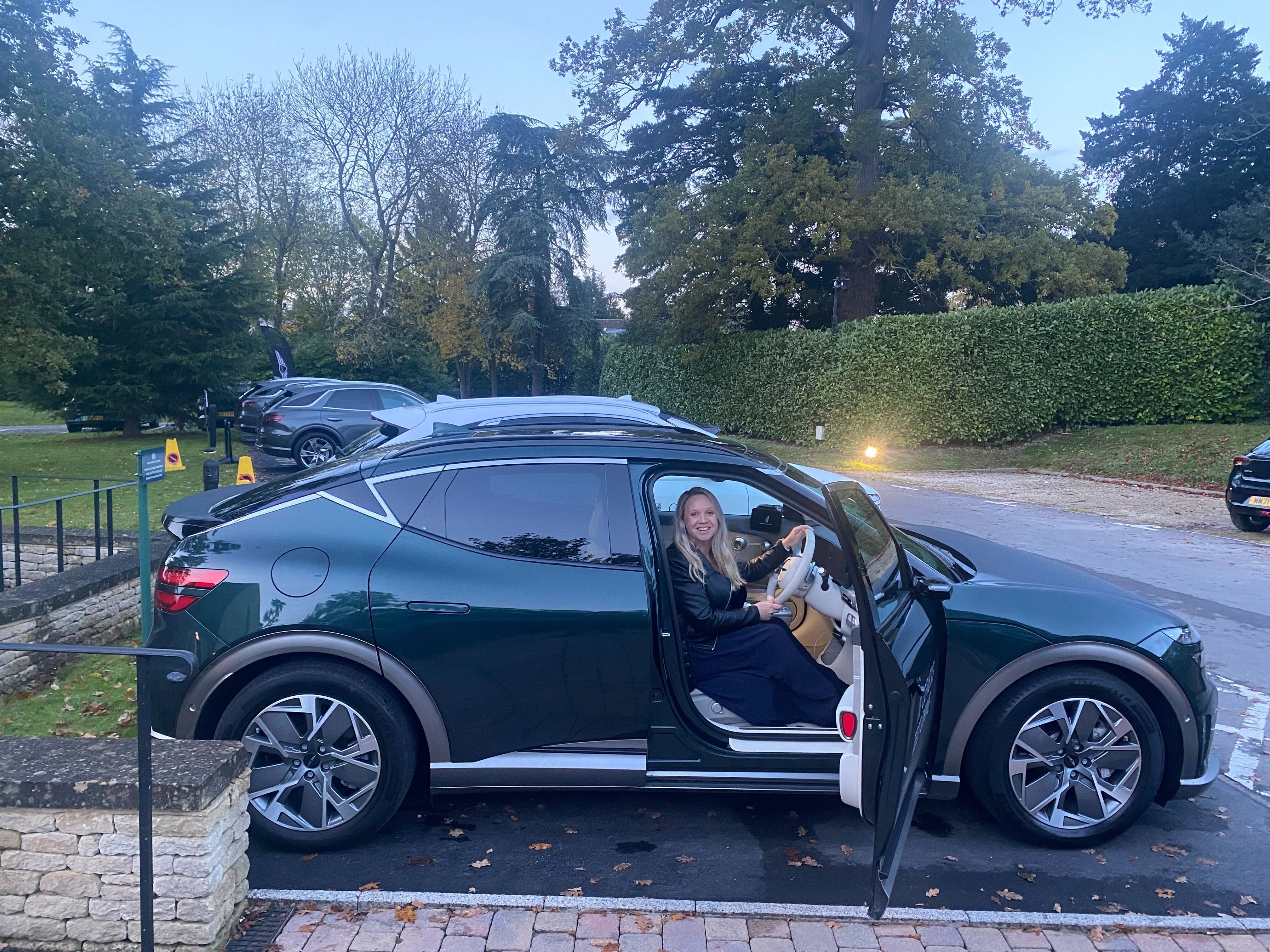
Zapmap’s Content Executive Nic test drives a Genesis GV60 at the She’s Electric event in Cheltenham
EVs: Not just boys’ toys
The future of electric mobility is more than just the technology. It’s about empowering everyone to make the switch. And here at Zapmap, a female-led company, we provide you with the tools to do so via our many EV guides, news, statistics - and of course through the app itself.
Melanie Shufflebotham, Zapmap Founder & COO, shares her thoughts on making the switch:
“I’ve been driving electric for over nine years. My initial motivation was the positive environmental benefits, but I could never go back now because I'm wedded to the smooth drive and simplicity of the automatic transmission - just press and go!
“At Zapmap our mission has always been to make charging simple. That means helping everyone to see the benefits of electric driving, and empowering them to make the switch. My message would be, just go for it!”
Taking charge of your driving experience and environmental impact is a responsibility for all, regardless of gender. With more women taking the wheel of an EV, we can ensure that the electric experience not only becomes more inclusive, but tailored to the needs and preferences of everyone.
